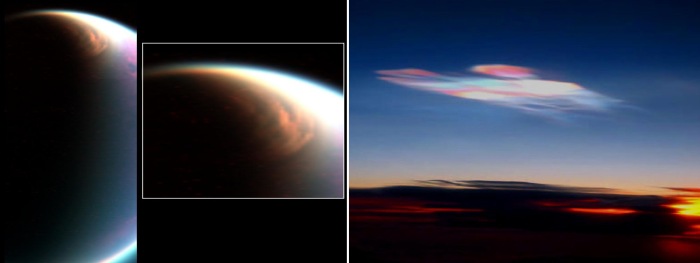When we think of chemistry, we often imagine a laboratory bench full of test tubes and a scientist in a white coat. But as we accumulate knowledge through such experiments, we start to formulate them into theories and hypothesis. Testing such hypotheses allows us to refine our theories, ultimately gaining predictive power. Additionally, computational chemistry methods provide us with a versatile tool, bringing atomic-level insights to processes beyond conditions attainable in the lab. It comes as no surprise that it is extensively applied for the search of chemical processes of the origin of life.
In this search, we are biased towards “life as we know it” – made of polymeric self-organising sequences in an aqueous media confined by a flexible lipid membrane. Life forms of this kind would only exist in Earth-like conditions, giving rise to the interest in planets in the “habitable zone” (planets that can have liquid water on their surface).

Titan, the moon of Saturn, with a cryogenic surface (-180 °C) cannot have liquid surface water. Instead, it has hydrocarbon (that exists as natural gas on our planet) seas, and it snows benzene. It also has a dense atmosphere with a wide diversity of organic molecules produced through photochemical reactions. It opens a playground for the ideas of exotic life.
Indeed, when recreating the chemistry of the Titan’s atmosphere, Horst et al. were able to observe the formation of nucleotides and amino acids, essential building blocks of polymers of our life. The significance here was that these core reactions, first discovered in Miller-Urey experiment, and believed to require water, could go on without it.
Furthermore, Stevenson et al. then postulated the possibility of formation of pseudo-membranes in liquid-water-free environments, by such aiming to expand the search for life beyond “habitable zone”. As an example, they studied self-assembly of molecules found on Titan. Within those, acrylonitrile was predicted to form a flexible inverse-membrane, named azotosome.
However, recent theoretical work by Sandström and Rahm curbs our excitement for finding traces of exotic life. Through molecular modelling, they studied other plausible structures that acrylonitrile could adopt in Titan’s frigid environment, where entropy plays a very small role. They demonstrated that its crystal is significantly energetically more stable than its membrane-like azotosome.
These two works demonstrate how, through computational chemistry, we can test and challenge new ideas in conditions unattainable on Earth. As a result, we are growing and evolving our understanding of the physicochemical processes and engaging in extensive discussions on the processes of life.
Computational methods are advancing, giving us the capacity to analyse the chemical space with increasing efficiency and to drive our imagination further, germinating new ideas.
by V Erastova
Key Articles:
- Hörst, S. M., Yelle, R. V., Buch, A., Carrasco, N., Cernogora, G., Dutuit, O., … & Szopa, C. (2012). “Formation of amino acids and nucleotide bases in a Titan atmosphere simulation experiment.” Astrobiology, 12(9), 809-817.
- Stevenson, J., Lunine, J., & Clancy, P. (2015). “Membrane alternatives in worlds without oxygen: Creation of an azotosome.” Science advances, 1(1), e1400067.
- Sandström, H., & Rahm, M. (2020). “Can polarity-inverted membranes self-assemble on Titan?” Science Advances, 6(4), eaax0272.
…or if lazy:
- “Computer says no to membrane-bound life on Titan“, Chemistry World News Article,